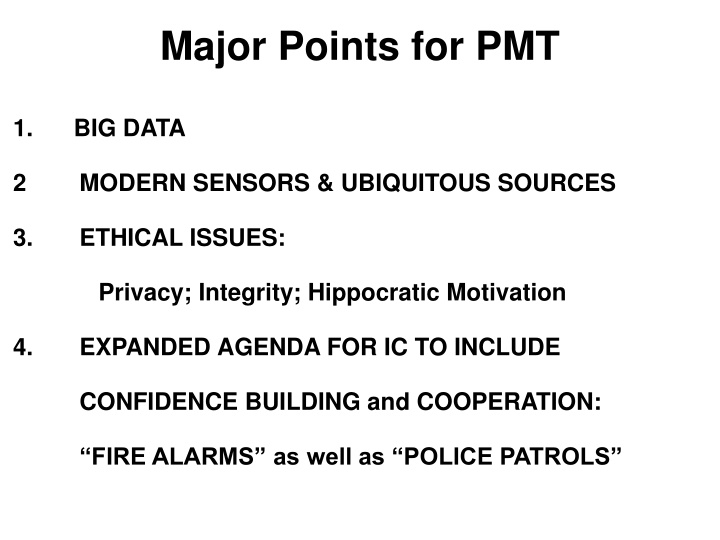
Big Data, Modern Sensors, and Ethical Issues in Public Technical Means
Exploring the significant points related to big data, modern sensors, and ethical considerations in the context of Public Technical Means (PTM) for treaty verification. The content discusses the potential of societal monitoring, challenges in PTM implementation, and relevant examples/models for PTM. It highlights the importance of data integrity, privacy, and societal cooperation in ensuring effective treaty compliance in the digital age.
Download Presentation

Please find below an Image/Link to download the presentation.
The content on the website is provided AS IS for your information and personal use only. It may not be sold, licensed, or shared on other websites without obtaining consent from the author. If you encounter any issues during the download, it is possible that the publisher has removed the file from their server.
You are allowed to download the files provided on this website for personal or commercial use, subject to the condition that they are used lawfully. All files are the property of their respective owners.
The content on the website is provided AS IS for your information and personal use only. It may not be sold, licensed, or shared on other websites without obtaining consent from the author.
E N D
Presentation Transcript
Major Points for PMT 1. BIG DATA 2 MODERN SENSORS & UBIQUITOUS SOURCES 3. ETHICAL ISSUES: Privacy; Integrity; Hippocratic Motivation 4. EXPANDED AGENDA FOR IC TO INCLUDE CONFIDENCE BUILDING and COOPERATION: FIRE ALARMS as well as POLICE PATROLS
PUBLIC DOMAIN TREATY COMPLIANCE: VERIFICATION IN THE DIGITAL AGE Christopher W. Stubbs and Sidney D. Drell
PTM Concept The distinguishing feature of Public Technical Means is the generation and analysis of open- access data, by the public, for treaty verification. PTM in the Future: Sensors Everywhere, and an Interconnected World PTM exists in numerous academic and national seismic research institutions that supplement the IMS for detecting and locating low-yield underground nuclear tests that violate the Comprehensive Test Ban Treaty.
2. PTM in the Future: (continued) In the rapid advances in information technology that can be, and are being, introduced into ubiquitous mobile sensors, many more pathways for data are rapidly opening up for a less structured form of PTM i.e. societal monitoring. The overall net effect of the rapidly evolving potential of public and societal monitoring is to make it much more difficult for governments to implement policies that violate established agreements and get away with such deception for very long.
Some Challenges Implementing PTM Treaty Verification The Data Integrity Problem: Detecting Spoofing and Deception Signal Discrimination Problem Standards Problem Privacy Issues: Anonymity and Retribution Incentivizing Enduring Public Engagement in PTM
Some Relevant Examples and Models for PTM A number of existing systems provide relevant examples and lessons for PTM. These include: The quake-catcher network, which exploits accelerometer data from laptops and mobile devices. Public analysis and inspection of satellite images, obtained from both Earth-observing and astronomical imaging systems.
The Galaxy Zoo project (see http://www.galaxyzoo.org) is a very promising example of public participation in image analysis, with clear applicability to the verification challenges of the decades ahead. The Galaxy Zoo project had the goal of using minimally trained citizen scientists to classify (with visual inspection) the characteristics of galaxies using digital astronomical images obtained with the Sloan Digital Sky Survey. The Survey obtained exquisite-resolution images of the entire Northern sky, and amassed a total of over 27 TeraBytes of imaging data and object catalogs.
The response was enormous. The Galaxy Zoo project attracted 250,000 online participants, from 170 countries. This public wave of amateur astronomers succeeded in classifying over 100 million galaxies, by visual inspection of every single image. The public participation in this project is comparable to the 300,000 individuals who have helped construct Wikipedia.
NEXT STEPS PTM Software PTM Sensor Layer PTM Communications Layer PTM Data Distribution Layer PTM Analysis and Data Fusion Layer People, Policy, and Governments: The Outermost PTM Interface Layer






















